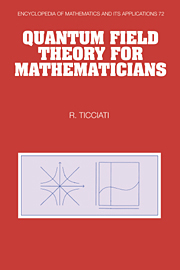Book contents
- Frontmatter
- Contents
- Preface
- Introduction
- 1 Relativistic Quantum Mechanics
- 2 Fock Space, the Scalar Field, and Canonical Quantization
- 3 Symmetries and Conservation Laws
- 4 From Dyson's Formula to Feynman Rules
- 5 Differential Transition Probabilities and Predictions
- 6 Representations of the Lorentz Group
- 7 Two-Component Spinor Fields
- 8 Four-Component Spinor Fields
- 9 Vector Fields and Gauge Invariance
- 10 Reformulating Scattering Theory
- 11 Functional Integral Quantization
- 12 Quantization of Gauge Theories
- 13 Anomalies and Vacua in Gauge Theories
- 14 SU(3) Representation Theory
- 15 The Structure of the Standard Model
- 16 Hadrons, Flavor Symmetry, and Nucleon-Pion Interactions
- 17 Tree-Level Applications of the Standard Model
- 18 Regularization and Renormalization
- 19 Renormalization of QED: Three Primitive Divergences
- 20 Renormalization and Preservation of Symmetries
- 21 The Renormalization Group Equations
- Appendix
- References
- Index
Introduction
Published online by Cambridge University Press: 31 October 2009
- Frontmatter
- Contents
- Preface
- Introduction
- 1 Relativistic Quantum Mechanics
- 2 Fock Space, the Scalar Field, and Canonical Quantization
- 3 Symmetries and Conservation Laws
- 4 From Dyson's Formula to Feynman Rules
- 5 Differential Transition Probabilities and Predictions
- 6 Representations of the Lorentz Group
- 7 Two-Component Spinor Fields
- 8 Four-Component Spinor Fields
- 9 Vector Fields and Gauge Invariance
- 10 Reformulating Scattering Theory
- 11 Functional Integral Quantization
- 12 Quantization of Gauge Theories
- 13 Anomalies and Vacua in Gauge Theories
- 14 SU(3) Representation Theory
- 15 The Structure of the Standard Model
- 16 Hadrons, Flavor Symmetry, and Nucleon-Pion Interactions
- 17 Tree-Level Applications of the Standard Model
- 18 Regularization and Renormalization
- 19 Renormalization of QED: Three Primitive Divergences
- 20 Renormalization and Preservation of Symmetries
- 21 The Renormalization Group Equations
- Appendix
- References
- Index
Summary
This text provides a mathematical account of the principles and applied techniques of quantum field theory. It starts with the need to combine special relativity and quantum mechanics, and culminates in a basic understanding of the Standard Model of electroweak and strong interactions. The exposition is enriched with as much mathematical detail as is useful for developing a practical knowledge of quantum field theory. All the details can be brought out in a three semester course, and the main ideas can comfortably occupy two semesters. The prerequisites for this presentation are (1) familiarity with the Hilbert-space formalism of quantum mechanics, (2) assimilation of the basic principles of special relativity, and (3) a goodly measure of mathematical maturity.
The book is divided into five parts. These cover (1) canonical quantization of scalar fields, (2) Weyl, Dirac, and vector fields, (3) functional integral quantization, (4) the Standard Model of the electroweak and strong interactions, and (5) renormalization. Each of the five parts introduces one primary new principle and, having developed that principle to a goodly degree of practicality, naturally motivates its own extension in the next part.
Part 1, Chapters 1–5, presents the principles that transform quantum mechanics and special relativity into canonical perturbative quantum field theory.
- Type
- Chapter
- Information
- Quantum Field Theory for Mathematicians , pp. xv - xviPublisher: Cambridge University PressPrint publication year: 1999



